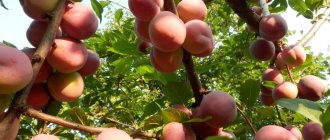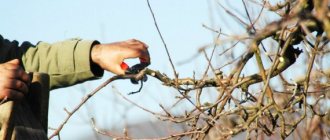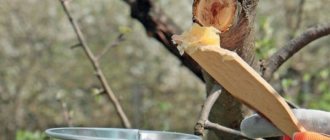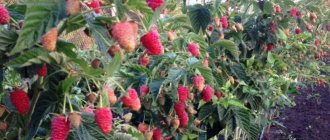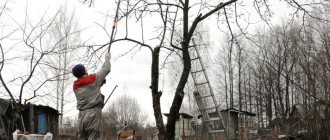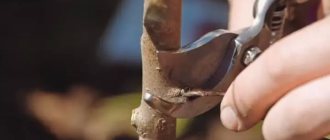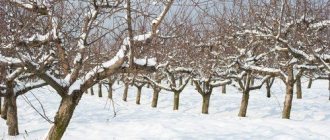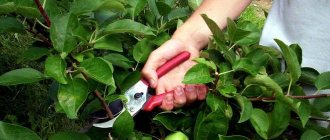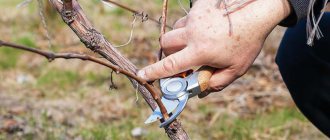Optimal timing for pear pruning in spring
Spring pruning of the pear must be done before the juice begins to flow in the shoots (i.e., before the buds open).
Debatable! At the same time, some gardeners advise carrying out the procedure when temperatures are still confidently below freezing (but not lower than -10 degrees), while others recommend that the air temperature, on the contrary, be positive (about +5). In any case, the duration of the pruning period is until the buds open.
We recommend reading these articles:
Treatment of trees in the spring during bud break
Treatment of shrubs in the spring during bud break
Treating shrubs in the spring against pests and diseases with Bordeaux mixture
Of course, it is quite difficult to indicate exact dates: spring in different regions, depending on the climate, begins at different times. The main thing is to be in time before the sap flow begins.
However, approximate dates can be given. Thus, pruning of pears in the spring in the central zone (Moscow region), as a rule, is carried out at the end of March - beginning of April, in the south of Russia - at the end of February-March. And in more northern (in the North-West - in the Leningrad region) and colder regions (in the Urals and Siberia), spring pruning of pears is carried out in the second half of April.
Common errors and how to fix them
When pruning fruit trees, gardeners often make the same mistakes. This increases the risk of developing fungal diseases and reduces yield. In some cases, this approach can even cause the death of the tree.
Common mistakes include:
- Wrong choice of timing. The garden should be pruned strictly before buds begin to bloom. At this time, the pears are in a dormant state, and sap flow is slow. Pruning is not too stressful for them. After the buds begin to bloom, you can remove a few branches, but do not carry out routine cleaning. If for some reason the deadlines were missed, it is worth cutting off only the damaged shoots and leaving the rest of the work until the fall. Summer pruning is always auxiliary, not the main one.
- Cutting off a large number of branches. You can trim no more than 30% of the branches at a time. This rule applies to crown rejuvenation. Some gardeners get too carried away with pruning. As a result, the pears experience severe stress. In this case, the tree may even die.
- Wrong choice of tool. Branches must be removed so that the cut surfaces remain as smooth as possible, without burrs. It is better to use pruners, saws, and garden knives. The entire instrument must be processed. You can wipe the blades with alcohol or a special solution.
- No cutting processing. If the branches are more than 1 cm in diameter, after cutting them, you need to disinfect the cut with a solution of potassium permanganate, or even better, cover it with garden varnish. Cutting areas should not be left untreated. They may become infected.
- Violation of pruning technology. Often inexperienced gardeners get lost and don’t know what exactly needs to be removed, which branches to remove and which ones to leave. A video for beginners will help you form the crown correctly. You can use step-by-step instructions in pictures.
- Reluctance to take into account varietal characteristics. When pruning pears, it is better to take into account not only general recommendations, but also the characteristics of the variety. For example, the Lada pear is very productive. If branches grow upward, they need to be removed. They simply can't handle a lot of fruit.
- The center conductor is not cut. During the period of formation, the crown needs to be trimmed every year. In older pear trees, such manipulation is already difficult.
Pears, like other fruit trees, must be formed strictly within the established time frame. The first 3-4 years are very important. If during this time it is not possible to give the crown the desired shape, it will be difficult to straighten it in the future.
Pruning a pear in the spring is a procedure that helps to properly form the crown, eliminate thickening, and also remove all diseased branches. It is important to carry it out within a certain time frame and in accordance with the recommendations of experienced gardeners. Using pruning schemes, you can even rejuvenate old pears and extend their fruiting period.
Pruning a young pear in spring
Pruning of pear trees begins in the first year and continues throughout the life of the tree.
- The first time a pear seedling is pruned is when planting in spring or autumn. This is necessary in order to maintain a fragile balance between the above-ground part of the plant and its root system, which will not be able to fully supply the growing crown with nutrients.
- Young trees must undergo formative pruning at least 2 times a year (spring and autumn). Its intensity depends on the propensity of a particular variety to branch.
- Along with pruning, in young fruit trees, to form more fruit buds, an agrotechnical technique such as bending branches is used. Using twine loops, the branches are tied to supports driven into the ground so that they take a horizontal position. The procedure is carried out in spring and summer. Bending pear branches closer to a horizontal position promotes the formation of fruit buds.
- To prevent the twine, wire or rope used for bending from cutting into the branch, disrupting the circulation of nutrients, a lining is made under them.
- The second tier of branches on a young pear is formed no earlier than the 4th year of development. By the age of five, the intensive growth of branches slows down, and pruning of the tree becomes more moderate.
Why prune a pear tree?
Pear seedlings in general are most often sold at 1-2 years of age; this is one of the most critical periods in the formation of the future crown of the tree. The manipulation will allow:
- Improve the condition of the cortex, strengthen it.
- Form the correct growth of skeletal branches.
- Improve the lighting level of the tree.
- Bring the fruiting period closer.
- Prevent the development of diseases transmitted by parasites living in cracks in the bark.
- Accelerate the process of development of the root system, which will help the plant adapt faster.
- Give the tree the most optimal height and shape.
Accordingly, the entire process should be carried out as responsibly as possible and taking into account a number of nuances. Only a planted pear is a fairly susceptible tree, and therefore, with the right approach, there is a chance to increase the plant’s chances of survival and accelerated fruiting.
Scheme for pruning a five-year-old pear:
- First of all, I prune the side branches to limit their growth,
- I cut off all the branches that grow inside the crown,
- I cut off branches that lie and hang over other shoots. This is dangerous because in this case both branches die due to the fact that the bark rubs against each other, becomes damaged and dies. And the branches eventually dry up,
- I cut off broken, dry branches,
- I shorten the branches to get a good growth of shoots,
- I make sure to cut off the conductor of the pear tree to allow the tree to continue to grow. Then it’s fashionable to get a not tall pear.
I always do the pruning with clean and sharp pruning shears. I cut the shoots into rings so that the cut areas become overgrown faster. Stumps should not be left, as pests and infections mainly live in them.
Set of tools and materials
The minimum set of tools and materials for high-quality pruning of young and mature trees includes:
- The main tool for pruning is a garden pruner (or lopper). Secateurs with short handles are convenient to remove small shoots (up to 1.5-2 cm), while pruners with elongated handles remove thicker branches (up to 3-4 cm).
- A garden (narrow) hacksaw with a special sharpening that ensures an even and neat cut, and a comfortable handle. It is used for cutting large branches.
- Garden knife. It is used for processing cuts and saw cuts, trimming bark, and cleaning affected areas of the trunk and branches.
- Stepladder or ladder. Facilitates access to parts of the crown remote from the ground.
Tools for pruning should be prepared in advance. Cutting edges must be clean and sharp. Before the procedure, it is advisable to disinfect them with alcohol or a solution of potassium permanganate, then wipe with a clean, dry cloth. If these tools are not available, you can lightly ignite the blades in the flame of a gas burner or a regular lighter.
Formative pruning of pear
The formation of a pear crown of this type is applied to seedlings or young plants. If you carry it out on time and correctly, the tree will grow and develop as expected. If the skeletal branches are distributed correctly, then fruiting will be early and fruit formation will be complete.
Attention!
Formative pruning on an adult pear concerns the removal of tops on the main shoots.
The rapid growth of branches can be stopped by shortening them. A similar manipulation is carried out on young plantings. As a result, the crown becomes compact.
But before pruning, you need to choose a crown for the pear. To do this, you should pay attention to the growing conditions of the crop. Sparsely layered and cup-shaped plants are more common.
Why is spring tree pruning necessary?
In the absence of pruning, the plant tends to expel vertical shoots and become very tall. This worsens yields and weakens the ability to resist disease and frost. Regular removal of damaged and excess branches is carried out to extend the fruiting period and improve the conditions for growing fruits .
Main purposes of pruning:
- formation of a strong skeletal foundation;
- uniform distribution of branches in the crown;
- maintaining the desired size of the branched part of the plant, convenient for maintenance and harvesting;
- ensuring access of light and air inside the crown - if there is a lack of them, the formation and growth of buds in shaded areas may slow down and stop;
- reducing the risk of disease and pests;
- rejuvenation of mature and old trees, extension of the fruiting period.
The video shows the formation of the crown by bending the branches. Filmed by the channel Sam Sadovod.
Sparsely tiered pear crown
This type of green mass is the most common and resembles natural forms. On the trunk, the shoots are arranged in tiers of 2-3 pieces or individually.
Formation of the crown of an annual seedling begins in early spring. For this purpose, a bole zone is allocated on the main conductor. It is located at a distance of 0.5 m from the surface of the earth. If it is smaller, then caring for an adult crop will be problematic. In the case of an enlarged bole, the pear will lose resistance to sub-zero temperatures and sunburn.
Above the trunk, another 30-40 cm must be measured, on which the skeletal shoots of the first tier will be located, and the conductor must be removed. The cut needs to be made above a healthy and developed bud - a shoot will appear from it, a continuation of the trunk. During crowning, the main branch should remain 15-20 cm higher than the shoots growing on the sides.
Another year later in the spring, gardeners clear the trunk of growth. There should be 3 branches left in the first tier, the distance between them along the trunk will be 10-15 cm. Their length is almost the same along the same horizontal line. Their circumferential growth will ideally be 100-120° between themselves. The remaining side shoots must be cut off or bent for a while so that they are parallel to the ground. This approach will slow down their growth, and, on the contrary, increase productivity.
Attention!
Branches whose length does not exceed 30 cm do not need to be removed - fruits will be set on them. They are almost not prone to growth.
On a three-year-old tree, a new one is laid 0.5-0.7 m from the lower tier. It is formed by 2-3 future skeletal shoots. The algorithm is the same as when forming the first tier. If the conductor has grown excessively, then it must be shortened. Branches that have been bent should not be touched. But if they make the crown very thick, then they will have to be shortened or completely removed.
On a four-year-old pear, 40 cm from the second tier, you can leave 2-3 branches of the third level. After 1-2 years, the conductor on the trunk must be shortened to the upper skeletal shoot growing from the side. The crown height should ideally be at least 4-4.5 m.
Sanitary pruning of pears in spring
The main purpose of this type of pruning is to maintain the health of the fruit tree. Branches can be shortened as needed at any time of the year, provided the air temperature is favorable. In this case, the following are subject to removal:
- broken or cracked tree shoots;
- fatty, growth shoots;
- dry branches affected by pests or disease;
- intertwined shoots.
Sanitary pruning of a pear avoids the spread of diseases and gives the tree a well-groomed appearance.
We recommend reading these articles:
When to plant pepper seedlings in 2022 in the Moscow region
Planting pepper seedlings in 2022 according to the lunar calendar in March
Feeding tomato and pepper seedlings with ammonia recipe
Pear care
If a pear seedling is planted in the fall, try to insulate the roots for the winter so that they are not damaged: after snow falls, sprinkle more in the root area.
In the first year of seedling development, it is necessary to remove growing weeds, mulch the soil and water regularly.
If you have a dry region, watering
Apply at least 1 bucket of water once a week; in the heat of the day, water 2 times a week with a bucket of water.
After watering, loosen the soil around the tree trunk.
Carry out treatments for diseases and various diseases.
In the first year of pear development, there is no need to apply fertilizer; they begin to feed with mineral fertilizers from the second year, and if organic fertilizers (rotted manure) were applied during planting, then the next feeding with such fertilizers is needed after 3 years no earlier.
Video - Pear. Planting and care
Rejuvenating pear pruning in spring
A special pruning method is used when it is necessary to rejuvenate fruit trees. This event is very relevant for trees over 15 years old. To effectively restore the fruit-forming ability of an old pear, it is recommended to adhere to the following pruning technology:
- It is best to carry out anti-aging pruning in several stages, keeping a time interval of a couple of years between activities;
- at the first stage, shoots located at an acute angle to the stem part should be removed;
- You should also remove all shoots located in a parallel direction to the trunk of the fruit tree;
- When pruning branches, you should not leave stumps or deepen the cut, as in this case the healing process will be greatly delayed;
- competent pruning is carried out using the ring method, which promotes the fastest healing of cuts;
- if the thickness of the branches is more than 3 cm, you must first make cuts from the bottom and top, which will not allow severe damage to the plant;
- All cut areas must be treated with a garden varnish.
We recommend reading these articles:
Fertilizing the soil in spring
What to do if the pepper does not sprout
Feeding petunia seedlings for growth at home
It is important to note that the annual growth of pear trees, unlike apple trees, is not recommended to be subjected to very heavy pruning. It is considered optimal to shorten it by a quarter of the original length. After the main anti-aging pruning, the crown is thinned and shoots that are directed deep into the crown or intersecting each other are removed.
Activities after pruning
At the end of the work, all cut branches should be removed from the tree, and it is better to burn the diseased ones as soon as possible. The cut areas are treated with garden varnish or painted over with oil paint. This prevents the penetration of infections and insect pests, reduces the loss of nutrients during sap flow. At temperatures below 8 ° C it is better to use paint - garden varnish does not adhere well to wood.
It is not recommended to fertilize the pear soon after pruning.
Treatment of cuts with garden varnish
How pear trees react to pruning
Sometimes a pear tree does not react to pruning the way you would like it to, and grows “in the wrong steppe.” Such disobedience depends on the variety and its inherent type of growth. Therefore, sometimes light pruning is combined with other techniques, for example, bending. There are varieties with apical (apical) dominance of shoots, and others with lateral dominance. There are those with good shoot formation, and those with poor shoot formation. There are varieties with a right angle of shoot emergence, and there are varieties with an acute angle (mesotonic and basiconic).
Varieties with a mesotonic type of branching with a wide angle of branching of branches are perfectly formed: Pamyati Yakovlev, Avgustovskaya rosa, Lastochka. It is a pleasure to form such varieties - we cut the young seedling to a standard height of + 20 cm and remove unnecessary side shoots in the summer - the tree forms itself. The forming scheme for such pears is sparsely tiered.
And a variety like Bryanskaya Krasavitsa has apical dominance. Those. all the growth force goes into one single shoot, which simply clogs the rest. It is impossible to form such a tree by pruning! When pruning, you get one or two shoots, but with such sharp angles that they literally run parallel to the trunk. Such varieties are formed with horizontal cordons. This is when one shoot is kicked out and then bent. The shoots that grow from the bending places are thinned out and again bent in the opposite direction, etc.
